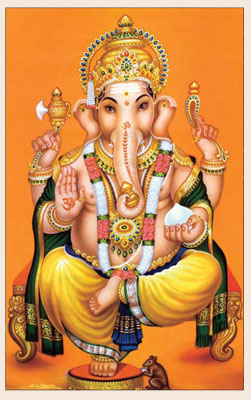
C H A P T E R 24§
Home Puja
________________§
A Simple, Traditional Worship Ceremony to Lord Ganesha that Anyone Can Perform—with English Translation, Illustrations And Internet Resources to Facilitate Learning the Chants§
________________§

 HE HINDU FORM OF HOME WORSHIP, KNOWN AS puja, is unique in all the world. Quite fittingly, it arises from the magnanimous spirit of hospitality that Hindu people are famous for. All guests are received and treated as God in the Hindu home, and God is no exception. During this daily morning rite, family members gather in their well-appointed shrine room to honor God as their royal guest. They receive Him warmly, offer a seat, serve water to quench His thirst, bathe and dress Him in beautiful clothes, burn the finest incense for His enjoyment, honor Him with light and flowers and feed Him a sumptuous meal. It is an intimate, personal interaction with God. Throughout the puja, the officiant chants sweetly to the Deity in Sanskrit, describing these kindly acts and beseeching His blessings. Finally, he thanks the Deity for His presence, bids Him farewell and humbly apologizes for any errors he may have committed. It is a ritual performed daily in millions of homes. In a sense, each Hindu has a private temple right in the home, and invites God to abide there, close to the family. Mystically, it keeps open the channels to the superconscious, divine areas of the inner worlds, bringing peace, health, prosperity and happiness to family members. Intellectually, it keeps religious beliefs strong. Emotionally, it cultivates a burgeoning love of God, known as bhakti. ¶Puja literally means “worship, adoration.” Home puja is a personal version of the public puja performed in temples by priests. The forms of puja vary widely between Hinduism’s four main denominations and its hundreds of lineages, but all puja finds its basis in sixteen offerings, shodasha upachara. These also vary somewhat, depending on the scriptural source that is followed, but one popular list is the following: 1) Āvāhanam, invoking; 2) Āsanam, offering a seat; 3) Pādyam, offering water for cleansing feet; 4) Arghyam, offering water for cleansing the palms; 5) Āchamanīyam, sipping water; 6) Snānam, ceremonial bath; 7) Vastram, offering vestments; 8) Yajñopavītam, offering sacred thread; 9) Chandanam, offering sandalwood paste; 10) Pushpam, offering flowers; 11) Dhūpam, burning incense; 12) Dīpam, waving lighted camphor; 13) Naivedyam, offering food; 14) Añjali, praying with folded hands; 15) Pradakshinā, circumambulation; 16) Udvasanam, farewell. Lord Ganesha is the God honored and worshiped by all Hindus, so here we present a puja for this universally beloved, boon-giving Lord of Beginnings and Ruler of Obstacles, which can be performed by anyone, young and old, Hindu or non-Hindu, Vaishnava or Shakta, Saiva or Smarta. It is Lord Ganesha who bridges all distinctions and unifies all peoples, and it is through His worship that we ultimately come to know all the other Gods. §
HE HINDU FORM OF HOME WORSHIP, KNOWN AS puja, is unique in all the world. Quite fittingly, it arises from the magnanimous spirit of hospitality that Hindu people are famous for. All guests are received and treated as God in the Hindu home, and God is no exception. During this daily morning rite, family members gather in their well-appointed shrine room to honor God as their royal guest. They receive Him warmly, offer a seat, serve water to quench His thirst, bathe and dress Him in beautiful clothes, burn the finest incense for His enjoyment, honor Him with light and flowers and feed Him a sumptuous meal. It is an intimate, personal interaction with God. Throughout the puja, the officiant chants sweetly to the Deity in Sanskrit, describing these kindly acts and beseeching His blessings. Finally, he thanks the Deity for His presence, bids Him farewell and humbly apologizes for any errors he may have committed. It is a ritual performed daily in millions of homes. In a sense, each Hindu has a private temple right in the home, and invites God to abide there, close to the family. Mystically, it keeps open the channels to the superconscious, divine areas of the inner worlds, bringing peace, health, prosperity and happiness to family members. Intellectually, it keeps religious beliefs strong. Emotionally, it cultivates a burgeoning love of God, known as bhakti. ¶Puja literally means “worship, adoration.” Home puja is a personal version of the public puja performed in temples by priests. The forms of puja vary widely between Hinduism’s four main denominations and its hundreds of lineages, but all puja finds its basis in sixteen offerings, shodasha upachara. These also vary somewhat, depending on the scriptural source that is followed, but one popular list is the following: 1) Āvāhanam, invoking; 2) Āsanam, offering a seat; 3) Pādyam, offering water for cleansing feet; 4) Arghyam, offering water for cleansing the palms; 5) Āchamanīyam, sipping water; 6) Snānam, ceremonial bath; 7) Vastram, offering vestments; 8) Yajñopavītam, offering sacred thread; 9) Chandanam, offering sandalwood paste; 10) Pushpam, offering flowers; 11) Dhūpam, burning incense; 12) Dīpam, waving lighted camphor; 13) Naivedyam, offering food; 14) Añjali, praying with folded hands; 15) Pradakshinā, circumambulation; 16) Udvasanam, farewell. Lord Ganesha is the God honored and worshiped by all Hindus, so here we present a puja for this universally beloved, boon-giving Lord of Beginnings and Ruler of Obstacles, which can be performed by anyone, young and old, Hindu or non-Hindu, Vaishnava or Shakta, Saiva or Smarta. It is Lord Ganesha who bridges all distinctions and unifies all peoples, and it is through His worship that we ultimately come to know all the other Gods. §
For puja supplies, Deities and more, visit www.minimela.com§

A young Hindu family share in morning worship, as father performs the traditional rite of worship called puja, honoring and invoking the blessings of the Elephant-Headed Lord of Dharma, the Deity worshiped by Hindus of all lineages.§